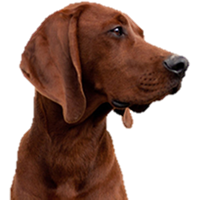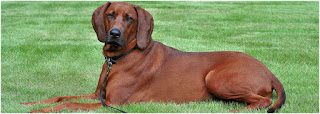AKC group: Hound
UKC group: Scenthound
Average lifespan: 11-12 years
Average size: 35-65 pounds
Coat appearance: Flat, shiny, and smooth
Coloration: Rich red
Hypoallergenic: No
Other identifiers: Strong, vigorous, and striking all around, clean, well-proportioned head, black nose, strong chest, brown eyes, long, floppy ears that are close to the nose, upright tail, and small paws with thickened pads.
History
In the late 18th century, many European-type hunting dogs were imported to America, most of them of Scottish, French, English, and Irish ancestry: the
English Foxhound, the Harrier, the Grand Bleu de Gascogne, the Welsh Hound, the Beagle, and the
Bloodhound were among these. Most often, these dogs were imported so that wealthy planters of the Tidewater could engage in foxhunting. Over time, Southern hunters selectively bred dogs that would not back down, had great stamina, and would
“hound” their prey until they treed or cornered their exhausted quarry, leading to modern coonhounds.

In the late 18th century Scottish immigrants brought red-colored foxhounds to Georgia, which would be the foundation stock of the Redbone. Later, approximately 1840, Irish-bred
Foxhound and
Bloodhound lines were added. The name came from an early breeder, Peter Redbone of Tennessee, though other breeders of note are Redbone’s contemporary, George F.L. Birdsong of Georgia, and Dr. Thomas Henry in the 19th century.Over time, breeders followed a selective program that led to a
coonhound that is specialized for prey which climbs trees, was unafraid of taking on large animals, was agile enough to carry on over mountain or in meadow, and liked to swim if necessary. They were ideal for pack hunting of both small and larger prey. Originally, the Redbone had a black saddleback, but by the beginning of the 20th century, it was an uninterrupted red tone.
Like many American hunting dogs, especially those from the South, they were widely known by hunters and farmers, but not well known in the show ring. The Redbone has found recognition by the two major American kennel clubs. Because of of its main use as a hunting dog rather than a show dog Redbones are extremely rare dogs outside of the United States. There are very few breeders outside of North America and it is virtually unknown in Europe or Australia.
The Redbone Coonhound was recognized by the United Kennel Club in 1902, becoming the second coonhound breed to gain recognition.
The Redbone Coonhound was popularized after the novel Where the Red Fern Grows, written by Wilson Rawls, was published in 1961. It told the story of Billy Colman and his Redbones.
The Redbone Coonhound was recognized by the American Kennel Club in 2010. It was shown at the Westminster Kennel Club Dog Show for the first time in 2011.
Redbone Coonhounds are determined, energetic, tenacious, tireless and fearless, especially while on the hunt. These personality traits are part of what make Redbones such fantastic scenthounds. In addition, Redbone Coonhounds are affectionate, friendly, kind-hearted, sensitive and extremely good with children and other animals. This is not a high-strung, fussy or clingy breed. Redbones adapt effortlessly to a wide variety of new situations. They are not suspicious or wary around strangers, nor are they overly boisterous or pushy. These are solid, stable hound dogs that can work in the field all day, and then comfortably relax with the family for a nice evening at home.
Health Problems
Problems with hip dysplasia affect this dog, but that is not uncommon and they have few other health problems, making them generally pleasant around veterinarians.
Care
Traditionally used as an outdoor dog, the Redbone has become more adaptable to indoor living with a family. It should be taken out on routine jogs, walks, or be allowed to swim nearby. However, these activities should only be done in safe and secure locations, as the dog can quickly roam off if it picks up a curious scent. While trailing or when excited, it has a loud and melodious voice.
To maintain its coat, the Redbone should be brushed weekly. Many Redbone Coonhounds also have a tendency to drool.
The Redbone Coonhound will do okay in an apartment if it is sufficiently exercised. These dogs are relatively inactive indoors and will do best with at least a large yard. Their all-weather coat allows them to live and sleep outdoors and work in all kinds of terrain.
Training
Redbone Coonhounds take well to training, and are so versatile and athletic that they can accomplish a high variety of tasks. Giving them tasks to fulfill – from swimming to hunting – can help it not only feel fulfilled, but help it feel like it plays a role in your pack. Every dog should certainly feel this way about humans, but should be trained with the discipline to realize that its role is subservient to every human in the house.
Exercise Requirements
Capable of a lot of exercise – and indeed, they were bred that way – this is a great outdoor dog and a good companion for someone who wants to get plenty of vigorous exercise. If you’re looking for a low-maintenance dog that likes to lay around the house, this is not your breed.
Training
Redbone Coonhounds take well to training, and are so versatile and athletic that they can accomplish a high variety of tasks. Giving them tasks to fulfill – from swimming to hunting – can help it not only feel fulfilled, but help it feel like it plays a role in your pack. Every dog should certainly feel this way about humans, but should be trained with the discipline to realize that its role is subservient to every human in the house.
The Redbone has a flashy, dark-red coat that’s short and smooth. Weekly brushing with a hound mitt or rubber curry brush will keep it clean and shiny, as well as remove dead hair so it doesn’t land on your floor, furniture or clothing.
Bathe your Coonhound as needed. He may have a bit of a “houndy” odor, which some people love and others hate. Bathing can help reduce the smell if you don’t like it, but it won’t take it away completely or permanently.
The rest is basic care. Trim the nails every week or two, and keep the ears clean and dry. Brush the teeth regularly with a vet-approved pet toothpaste for good overall health and fresh breath.
Is this breed right for you?
Great with children, the Redbone Coonhound will adapt to family life with ease. Loving and loyal, this dog loves his owner with passion. A great hunter, he can adapt well to the working life or be happy as a playmate. In need of a fenced-in yard, he has the natural instinct to sniff out his prey, including cats. Trained easily if done so at a young age, this breed is a great addition to add to a household.
Did You Know?
The man who did the most to develop the breed was named George E. L. Birdsong, a well-known fox hunter and dog breeder who lived in Georgia.
A dream day in the life of a Redbone Coonhound
Waking up ready to play, he’ll greet you with a lick. Once you pet him and show him love, he’s ready for his meal. After breakfast, he’ll enjoy a fun walk and sniff around the block. Engaging in any activity the kiddos present him, he’ll follow them around with ease. Happy to nap inside or outside, he’ll need a lot of time in the backyard. After dinner, he’ll enjoy a good rubdown, a swim in the pond and a lot of attention before he takes a snooze with his master.






